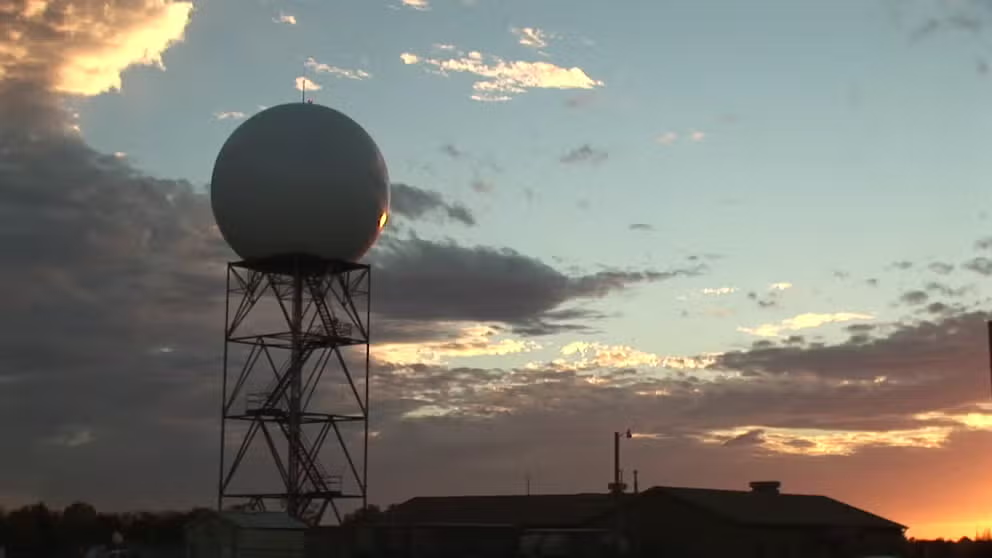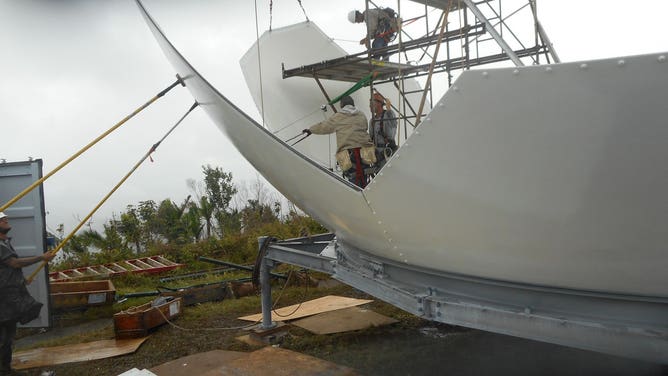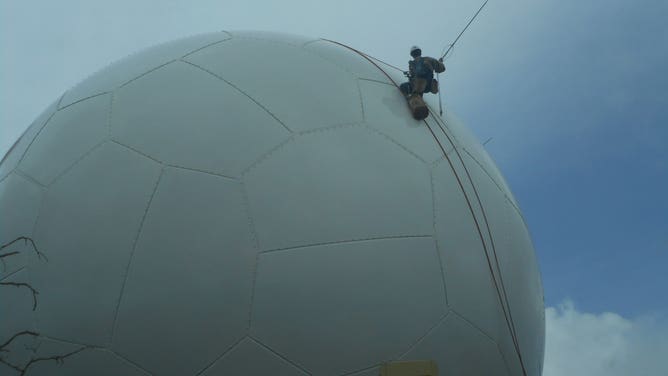How weather radars have saved lives for over 30 years
Topped by their signature white spheres, radars keep an eye on the sky
NEXRAD: Protecting people from severe weather
The NEXRAD Radar Operations Center has 159 radars sprinkled across the country and at select locations overseas.
They keep their eyes on the sky.
Known by their signature white spheres, weather radars silently stand guard as they gaze into the depths of the atmosphere.
Like soldiers on watch, they peer out to see what looms in the distance, ready to report what lies ahead.
The ripple effect of radars

A National Weather Service radar stands at Dona Ana County International Jetport in Santa Teresa, New Mexico, on Tuesday, Oct. 22, 2019.
(Cate Dingley / Bloomberg / Getty Images)
"The radars are important because they are the forecasters’ primary tool for identifying and warning on impending severe weather," said Jessica Schultz, the deputy director of the NEXRAD Radar Operations Center.
The NEXRAD Radar Operations Center — or simply "NEXRAD" — is part of the National Weather Service (NWS). Based in Norman, Oklahoma, NEXRAD relays vital information to forecasters, who then deliver that information to the general public.
HOW TO WATCH FOX WEATHER ON TV
"It's a pretty picture [the public] might see on TV or on their phone, but it's scientific data that allows forecasters to provide the public with warnings to take action if there's something hazardous headed for them," Schultz said.
And that’s not all. According to Schultz, NEXRAD’s radars also make a significant impact on three other realms: the economy, the military and air travel.

Thunderstorm on July 31, 2017 in Safford, Arizona.
(Jason Weingart / Future Publishing / Getty Images)
The radars are essential to commerce as they help ensure the safe transportation of goods and services across the country. For example, the trucking industry needs to know the weather as their truckers drive from one coast to the other.
For the military, weather forecasts help them protect certain assets. In one scenario, the military needs to know whether high winds or hail might approach and potentially damage helicopters and airplanes sitting on bases.
LEARN WHAT TO DO WHEN A HURRICANE WATCH OR WARNING IS ISSUED FOR YOUR AREA
Lastly, information from the radars helps the Federal Aviation Administration (FAA) ensure the safe navigation of airplanes across the country.
"That's why those three agencies are invested cooperatively in the radars to ensure that our nation has proper radar coverage, and we can see any hazards approaching the country," Schultz said.
How the radars work
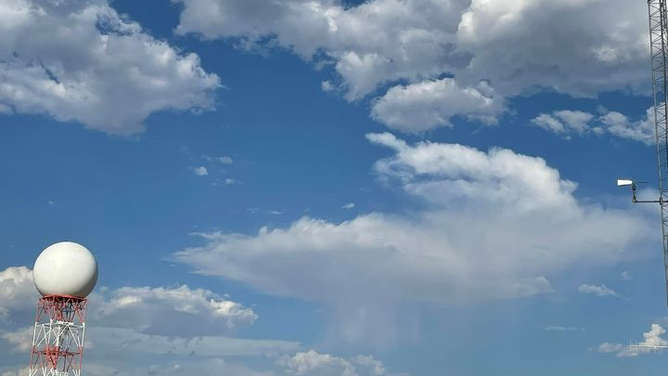
Radar with cloudy sky in the background at NWS San Angelo, Texas.
(NWS San Angelo)
The NEXRAD Radar Operations Center has 159 radars sprinkled across the country and at select locations overseas, such as Puerto Rico, Guam, Korea and Japan.
This network of radars is called the WSR-88D, which stands for Weather Surveillance Radar 1988 Doppler. The radars of WSR-88D were deployed in the early to mid-1990s and have been continuously upgraded and maintained in the years since.
"When the radars were originally located, they were primarily located based on severe weather probability," Schultz said. Because of this, most of the radars are located east of the Rocky Mountains as that portion of the country experiences a greater probability of severe weather.
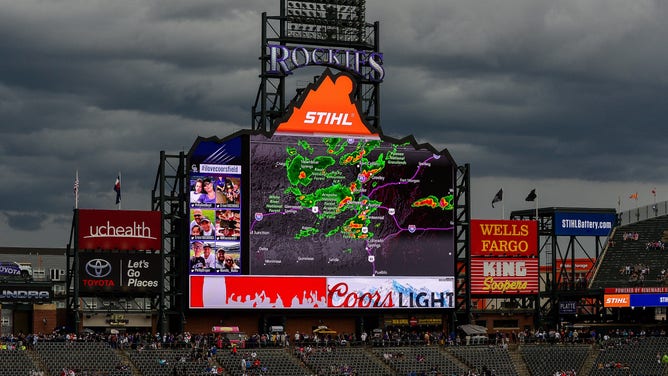
The outfield scoreboard at Coors Field displays a view of the weather radar during a delay before a scheduled game between the Colorado Rockies and the Miami Marlins on June 24, 2018 in Denver, Colorado.
(Dustin Bradford / Getty Images)
"But the West and then, of course, the United States territories are well-covered to serve the public and the mission of those three federal agencies as well," Schultz added.
LEARN WHERE TORNADOES ARE MOST LIKELY TO OCCUR EACH MONTH
The radars are ground-based, and they can see from the level of the horizon to about 70,000 feet up.
"That provides us a good snapshot of severe weather in that range in the atmosphere," Schultz said.
To see what the atmosphere holds, the radar sends out signals to detect small objects in the clouds, such as raindrops and ice pellets. That information is then sent to a series of computers that can interpret the signals into visual images, helping relay weather information to the public.
CLICK HERE TO GET THE FOX WEATHER UPDATE PODCAST
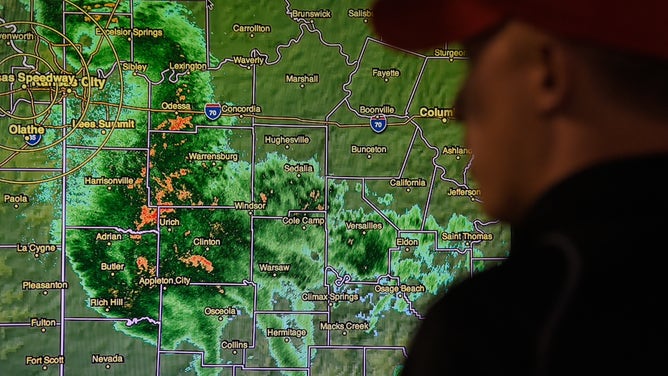
Weather radar as seen in the pit box during a rain delay at the Kansas Speedway on May 9, 2015.
(Ed Zurga / Getty Images)
This information is constantly being relayed, due to the radars’ placement in relation to each other.
"Within the United States, our radar coverage is overlapping in most cases, and that was done strategically to ensure that if one radar goes down for maintenance, for example, or if there's an unexpected issue, that there are surrounding radars that can provide that coverage until the radar can return to service," Schultz said.
She added that NEXRAD supplements WSR-88D’s system with other radars, such as the FAA’s smaller radars that are located around larger airports.
Combined with these backups, WSR-88D’s 159 radars can ensure the flow of information to forecasters and the public.
The radomes
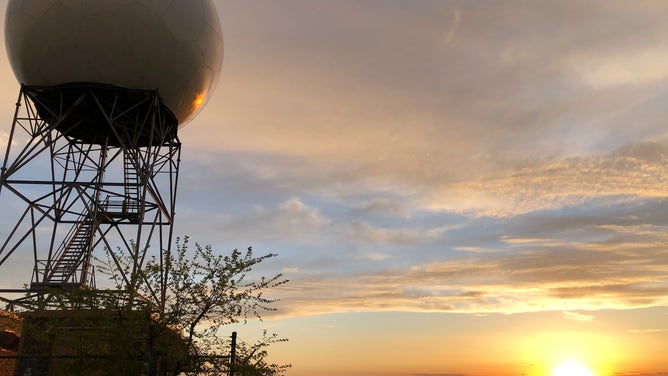
The radar at sunset in Jefferson County, Wisconsin.
(NWS Milwaukee)
While the radars work behind the scenes to gather and deliver vital information about weather, they are still recognizable due to their signature look: towers topped with giant, white spheres.
"The top of the radar, which most people think looks like a soccer ball, that's called the radome," Schultz said.
Inside the radome is a large satellite dish that serves as an antenna, along with several heavy mechanical components that allow the satellite dish to spin around 360 degrees.
This maneuverability is one of the reasons for the radome’s spherical shape, according to Schultz.
Its shape also helps protect the radar’s machinery from the elements.
The radome has aerodynamic properties that divert winds of up to 224 miles per hour around the sphere, making it resilient during weather events such as tornadoes and hurricanes.
LEARN HOW CLOUDS AFFECT THE CLIMATE ON EARTH
The spherical shape also allows precipitation to run off the radome. According to Schultz, that enables the radar’s signal to go out properly and be received without being impeded by raindrops, snow or ice.
"The radar operates 24/7 to be looking for hazardous weather," she said. "So, the radome serves an important process in making sure all that heavy equipment inside is protected from all the elements."
Onward and upward
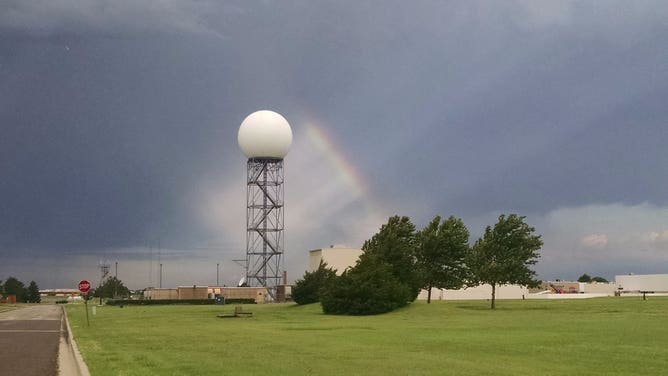
A rainbow beams next to the radome at NEXRAD ROC in Norman, Oklahoma.
(NEXRAD ROC)
According to Schultz, NEXRAD’s radar system is currently undergoing its latest phase of upgrades. Starting in 2015 and set to be complete in 2024, this phase is part of a service life extension program involving a major refurbishment and upgrade of all the radars.
"Some of the large mechanical components were original to the system, so they were 25 or 30 years old," Schultz said. "So, we have refurbished those, and that will keep the WSR-88D viable and providing high-quality data until at least the 2030s."
For decades, this network of radars has played a critical role in reading the atmosphere. Much like the radars, a large team works together to ensure that the radar operations go off without a hitch.
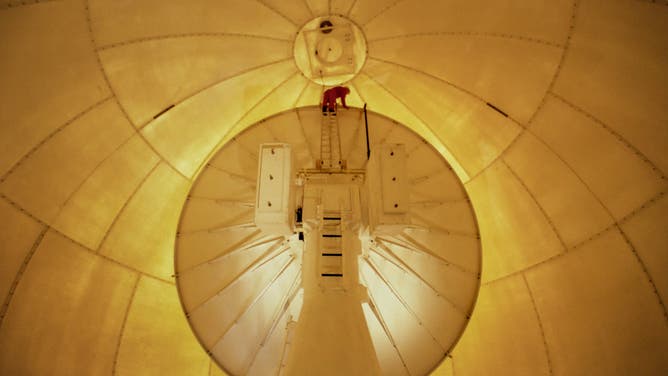
An employee works at the top of the weather radar within the radome.
(Brownie Harris / Corbis / Getty Images)
"The majority of our employees have been here for 20-plus years," Schultz said.
She noted that the radars are a very large and complex system that requires a lot of effort and planning to run. But what makes those efforts worthwhile is seeing how the forecasts that the radars shape help save countless lives and property.
"It's very rewarding to see that pay off," Schultz said. "When there's a major weather event, we know that the work that we do — we all take very much pride in the work that we do — we know that that effort is paying off to keep people safe that well."
